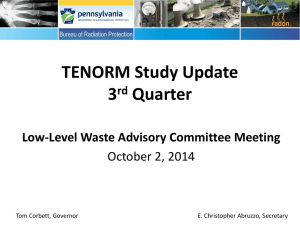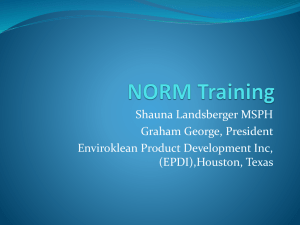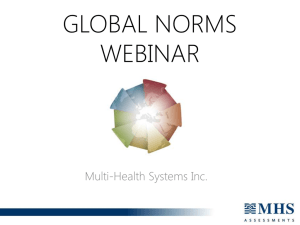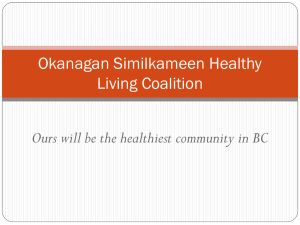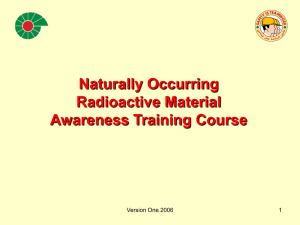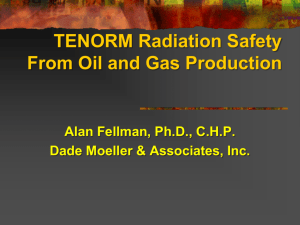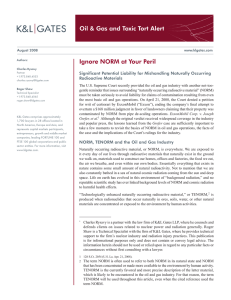What Do Workers in the Field Need to Know about
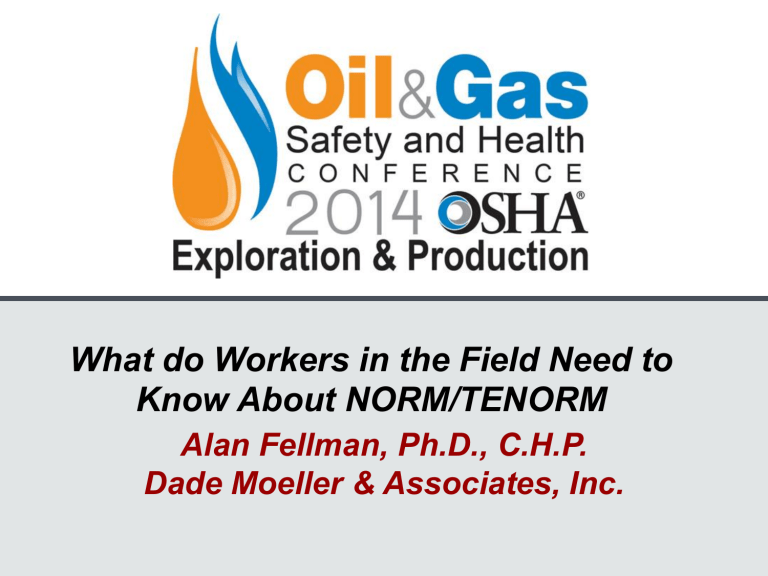
What do Workers in the Field Need to
Know About NORM/TENORM
Alan Fellman, Ph.D., C.H.P.
Dade Moeller & Associates, Inc.
Outline
• Definitions
• Sources and types of NORM/TENORM
• NORM Regulations
• Oil and Gas Industry NORM Wastes
• NORM/TENORM Radiation Safety
December 2-3, 2014
NORM as a Public Health Issue and a Public Perception Issue
• Basic interactions of people and their environment
• Must understand, assess, and control
– Impacts of people on their environment
– Impacts of the environment on people
• Oil and Hydraulic Fracturing waste may contain radioactive materials
What are these materials?
When is this a concern?
When/how is it regulated?
December 2-3, 2014
Definitions
NORM: Naturally Occurring
Radioactive Material – U, Th, Ra, Rn, etc.
or if you prefer:
Cheers regular; loves beer
Some oil and gas drilling waste (shale)
Fertilizer (from phosphate ores – uranium)
Rare earth mine tailings (uranium, thorium)
Ceramic products (uranium in clay)
Welding rods (thorium sands in coatings)
December 2-3, 2014
Definitions (Cont’d)
• TENORM: Technologically Enhanced NORM
– natural material whose radioactive concentrations have been enhanced by human activities including:
Oil & gas pipe scale
Oil & gas sludges
Selected mining wastes
Coal ash (concentrated uranium & thorium)
December 2-3, 2014
Ionizing Radiation –
Why Worry?
• Ionizing radiation health risks:
Acute effects – high levels of radiation produce effects such as blood chemistry changes, nausea, fatigue, various skin effects, cataracts, and death
Delayed effects – at some lower level of radiation, can increase risk of some cancers
• What about at typical environmental and occupational dose levels? No risk? Hormesis?
What are the implications?
• Radiation is a weak carcinogen compared to other materials (beryllium, asbestos, tobacco smoke…)
December 2-3, 2014
Background Radiation
People around the world are continually exposed to radiation from natural sources
• These sources include:
Cosmic radiation from outer space
Terrestrial radiation (materials in the earth)
• Internal radiation from materials taken into the body through breathing air, drinking water, and eating foods
December 2-3, 2014
Sources and Types of
NORM/TENORM
• Oil field pipe scale (radium)
• Oil field/refinery sludge (radium)
• Geothermal waste (radium)
• Drinking water purification waste
(uranium/radium)
• Metals and tailings from certain ores
(rare earth elements)
• Coal fly/bottom ash
December 2-3, 2014
Oil & Gas Industry
• NORM/TENORM present in all phases
• Concentrations depend on geology
Higher concentrations in production phase
(scale/sludge)
Drill cuttings
Produced water/flowback water
Radon decay products in gas production equipment
• Gas well drillers often use well logging to determine radiation levels to find gas
December 2-3, 2014
NORM Contamination
• Radon gas, external exposure, internal exposure
• Potential:
Worker exposure
General public exposure (and associated litigation risks)
Environmental impact
December 2-3, 2014
Who Regulates NORM?
• EPA – sets federal radiation standards for the public
• OSHA – has authority over hazardous materials in the workplace
• States
NORM-specific regulations
Clean Air Act
Clean Water Act
Workplace dose rates
Waste management
December 2-3, 2014
Waste Characterization
• Generators have the responsibility to know about their waste and appropriate management
– DOT HAZMAT issues
• Generators should know waste characterization:
Can be done through analytical testing, or
Through generator knowledge of a waste based on defensible and demonstrated factors
If uncertain, generators have the responsibility to perform analytical testing
December 2-3, 2014
Oil Field Waste
• NORM radionuclides may be concentrated in the oil recovery process
Radium is more soluble in brine solutions than uranium or thorium
Carbonates and sulfates of calcium, barium, and strontium may precipitate as pipe scale
Radium will also precipitate in pipe scale
Sludge in refineries may also contain radium
December 2-3, 2014
Oil Field Waste: Example
Radionuclide Content
Radionuclide
Average Sludge Average Scale pCi/g pCi/g
210 Po
210 Pb
226 Ra
228 Th
228 Ra
Total:
56
56
56
19
19
206
360
360
360
120
120
1,320
Note: Typical radium-226 in soil is ~1 pCi/g
* EPA Data
December 2-3, 2014
Oilfield NORM/TENORM – Who is
Exposed?
• General site workers
• Maintenance personnel – cutting, grinding, welding, scraping, dismantling pipes
(scale/sludge)
• Pipe/equipment recyclers
• Personnel involved in remediation and decontamination operations
• Waste handlers/transporters
December 2-3, 2014
Oilfield NORM/TENORM – Who
Else Could be Exposed?
• Members of the public
– Landowners who have leased mineral rights
– Transportation of wastes containing radioactive materials
– Water treatment plant workers – they are members of the public with respect to radiation regulations
• Legal Implications?
Radiation Safety at a NORM
Facility
• Written Radiation Safety Program
• Training
• Survey Activities:
Instrument surveys for dose rate, contamination
Collect airborne dusts
Restrict pipe cutting area
PPE – air filter, gloves, other
December 2-3, 2014
Radiation Safety at a NORM
Facility (continued)
• Instrumentation
• Dose Monitoring
• Record-keeping – if there’s no record, then it wasn’t done
– Can you defend your program if challenged?
– We live in a very litigious society so this can’t be stressed enough
What it all means to the operator
• Be familiar with your State’s regulations
• Develop a worker protection plan
• Manage and dispose of NORM waste properly
• Provide NORM training to workers
• Know your NORM environment:
Sampling
Field Measurements
December 2-3, 2014
Summary
• Not all States Regulate NORM/TENORM
• Wide range of State regulations
• Several States considering regulation of
TENORM
• Increase in oil and gas drilling in northern states
December 2-3, 2014
Questions/Comments?
Contact Information:
Alan Fellman
(301) 990-6006 ext. 3302 alan.fellman@moellerinc.com
December 2-3, 2014
